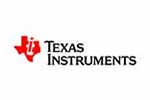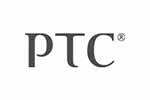Three-dimensional chess is an extremely beautiful and logical game, known and respected from one edge of the galaxy to another. From Cestus III to the planet Vulcan, from Sol III to the very heart of the Klingon Empire, it is played by numerous forms of intelligent life and honoured for its cool logic.
This Pragyan, explore 3D chess that has boggled minds in and out of space and across the galaxies.
Attractive goodies to be won.
Please post your queries related to this event at http://discuss.pragyan.org/t/chess-event/46
Day 1 and Day 2: 3D Chess
Day 3: Lightning Chess
STAR TREK 3D CHESS
Article 1: The nature and objectives of three-dimensional chess
1.1 Three-dimensional chess is played between two opponents who move pieces or attack boards alternately on a game set called a '3D-Chessboard'. The player with the white pieces commences the game. A player is said to 'have the move', when his opponent's move has been completed.
1.2 The objective of each player is to place the opponent's king 'under attack' in such a way that the opponent has no legal move which would avoid the 'capture' of the king on the following move. The player who achieves this is said to have 'checkmated' the opponent and to have won the game. The opponent who has been checkmated has lost the game.
1.3 If the position is such that neither player can possibly checkmate, the game is drawn.
Article 2: The initial position of the pieces on the 3D-Chessboard
2.1 The 3D-Chessboard is composed of 3 main boards and 4 movable attack boards.
2.2 A main board is composed of a 4x4 grid of 16 equal squares alternately clear (the 'white' squares) and coloured (the 'black' squares).
2.3 An attack board is composed of a 2x2 grid of 4 squares.
2.4 By looking at the 3D-Chessboard from the top, the 3 main boards form one board, 8 squares long and 4 squares wide. The lower-most board is termed "White's Board (W)", the middle board is the "Neutral Board (N)" and the top board is "Black's Board (B)".
2.5 The attack boards start the game on the rear pins of the White and Black Boards, and are referred to as "Queen's Level (QL)" and "King's Level (KL)" depending on which side of the board they are located.
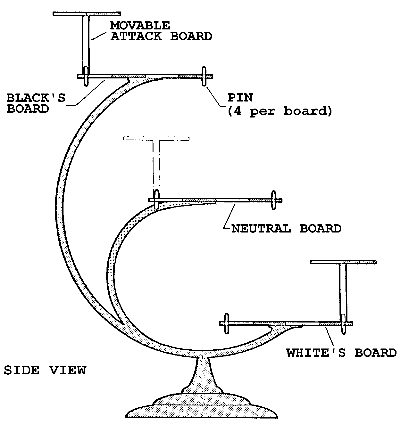

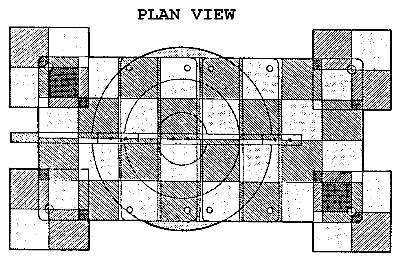
2.6 At the beginning of the game one player has 16 light-coloured pieces (the 'white' pieces) and 2 'white' attack boards; the other has 16 dark-coloured pieces (the 'black' pieces) and 2 marked ('black') attack boards.
The pieces are as follows:
a white king, a white queen, two white rooks, two white bishops, two white knights, eight white pawns;
a black king, a black queen, two black rooks, two black bishops, two black knights, eight black pawns.
2.7 The initial position of the pieces on the chessboard is as follows:
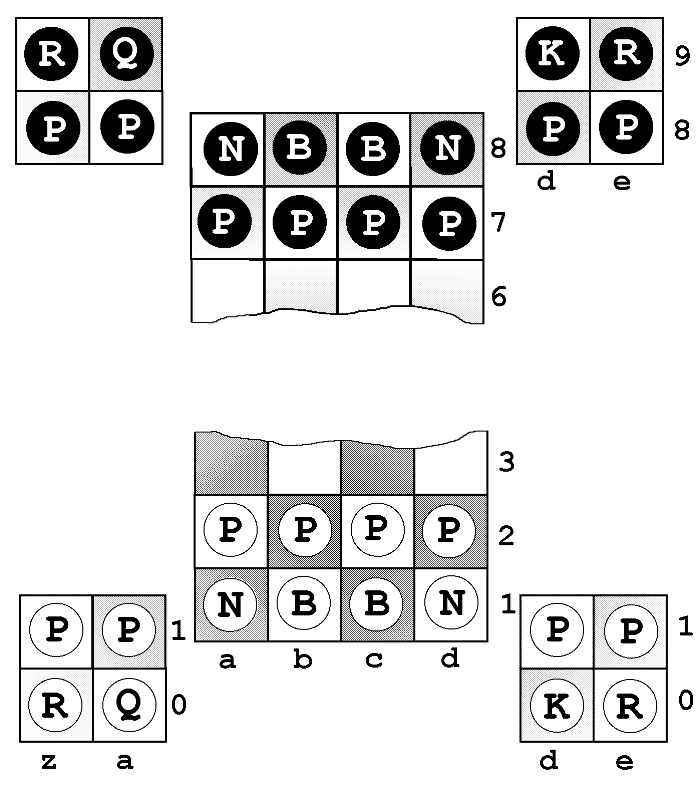
2.8 By looking from the top: The vertical columns of squares are called 'files' (z, a, b, c, d, e). The ten horizontal rows of squares are called 'ranks'. A straight line of squares of the same colour, touching corner to corner, is called a 'diagonal'.
Due to the attack boards a 3D-Chessboard has a very individual shape, which may vary. Consequently, there are squares which are part-time or permanently (e.g. b0) non-existent. Also, non-existent squares are part of 'files', 'ranks' and 'diagonals'.
Article 3: The moves of the pieces and of the attack boards
|
3.1
|
(a) Any move which can be made in a standard chess game (i.e. flat board), can be made in three-dimensional chess. Since every overlapping square is the same colour, you have the option of deciding which level you wish a piece to land on. For this reason two pieces of the same (or different) colours can occupy the same square (on different levels).
|
| |
(b) No piece can be moved to a square (on the same level) occupied by a piece of the same colour. If a piece moves to a square occupied by an opponent's piece the latter is captured and removed from the chessboard as part of the same move. A piece is said to attack a square if the piece could make a capture on that square according to Articles 3.2 to 3.5. A piece is considered to attack a square, even if such a piece is constrained from moving to that square because it would then leave or place the king of its own colour under attack (compare Article 3.5(b)).
(c) A piece, on any individual square, blocks the ability of other pieces to move at all levels (according to Article 3.1(a) and 3.2 to 3.5). But the moving piece may land above or below the occupied square and continue its move on the next turn.
(d) Vertical moves without horizontal movement of a piece are forbidden. I.e., a piece cannot move to the same square on another level.
(e) A move which ends on a non-existent square is forbidden. (See Article 2.8)
|
|
3.2
|
(a) The queen moves to any square along the file, the rank or a diagonal on which it stands.
(b) The rook moves to any square along the file or the rank on which it stands.
(c) The bishop moves to any square along a diagonal on which it stands.
|
When making these moves the queen, rook or bishop cannot move over any intervening pieces. (See Article 3.1(c))
3.3 The knight moves to one of the squares nearest to that on which it stands but not on the same rank, file or diagonal. It does not pass directly over any intervening square.
|
3.4
|
(a) The pawn moves forward to the unoccupied square immediately in front of it on the same file, or
(b) on its first move the pawn may advance two squares along the same file provided both squares are unoccupied (a pawn which has been moved by the move of an attack board (see Article 3.6) is NO LONGER allowed to move two squares) , or
(c) the pawn moves to a square occupied by an opponent's piece which is diagonally in front of it on an adjacent file, capturing that piece.
(d) A pawn attacking a square crossed by an opponent's pawn which has advanced two squares in one move from its original square may capture this opponent's pawn as though the latter had been moved only one square. This capture can be made only on the move following this advance and is called an 'en-passant' capture. According to Article 3.1(a) you have the option of deciding which level you wish the pawn to land on. A pawn which has been moved by the move of an attack board (see Article 3.6) cannot be captured 'en passant'.
(e) (i) When a pawn reaches the rank furthest from its starting position it must be exchanged as part of the same move for a queen, rook, bishop or knight of the same colour. The player's choice is not restricted to pieces that have been captured previously. This exchange of a pawn for another piece is called 'promotion' and the effect of the new piece is immediate.
(ii) Which rank is considered 'furthest' depends on the specific situation during the game. For files b and c, rank 1 (or 8) would be considered 'furthest'. For files z and e, rank 0 (or 9) would always be 'furthest'. For files a and d, the furthest rank varies depending on whether an attack board overhanging the corner is present. If present, the furthest rank is 0 (or 9). If not present, the furthest rank is 1 (or 8).
(iii) A special situation comes up, if a white pawn is located on a8B or d8B (or a black pawn on a1W / d1W) and is not 'promoted', because an attack board is overhanging the corner. If the attack board leaves later on that corner, the pawn will be 'promoted' before the next move will be done. (This implements that such an attack board move is prevented temporarily, if this move would place the king of its own colour under attack - see Article 3.5(b).)
|
|
3.5
|
(a)The king can move in two different ways, by:
(i) moving to any adjoining square that is not attacked by one or more of the opponent's pieces,
or
(ii) 'castling'. This is a move of the king and either rook of the same colour on the same rank, counting as a single move of the king and executed as follows:
To castle on the king's side: The king exchances its place with the rook.
To castle on the queens's side: The king is transferred from its original square to the square beside the rook, then that rook is transferred to the square the king has vacated.
(1) Castling is illegal:
| |
[a] as first move, or
[b] if the king has already been moved, or
[c] with a rook that has already been moved.
|
(2) Castling is prevented for the time being:
| |
[a] if the square on which the king stands, or the square which it is to occupy, is attacked by one or more of the opponent's pieces.
[b] if there is any piece between the king and the rook with which castling is to be effected.
|
(b) The king is said to be 'in check', if it is under attack by one or more of the opponent's pieces, even if such pieces cannot themselves move. Declaring a check is not obligatory. A player must not make a move which places or leaves his own king in check.
|
3.6 An attack board can only be moved, if it holds no more than one piece (regardless which piece that is). Attack boards are controlled by the player whose piece is located on it. Empty attack boards are the property of the original owner (marking).
The movement of an attack board is similar to the move of a rook. The distance is any adjacent pin. "Adjacent" means the next pins of the same or the next main board. (Levels 1 & 6 have three, levels 2 & 5 have four, and levels 3 & 4 have five adjacent pins.) Also, only empty attack boards can be moved to an inverted (i.e. backward) pin position. Occupied attack boards can only move forward or to the side.
The diagram below should help to better understand the meaning of "adjacent pin". A 'black' attack board located at Queen's Level 6 (QL6) has three adjacent pins: QL5 and QL4 can be reached with a move forward, King's Level 6 (KL6) can be reached with a move to the side.
A 'white' attack board located at QL3 has five adjacent pins: QL5, QL4 and QL2 in front, KL3 beside and QL1 inverted (i.e. backward).
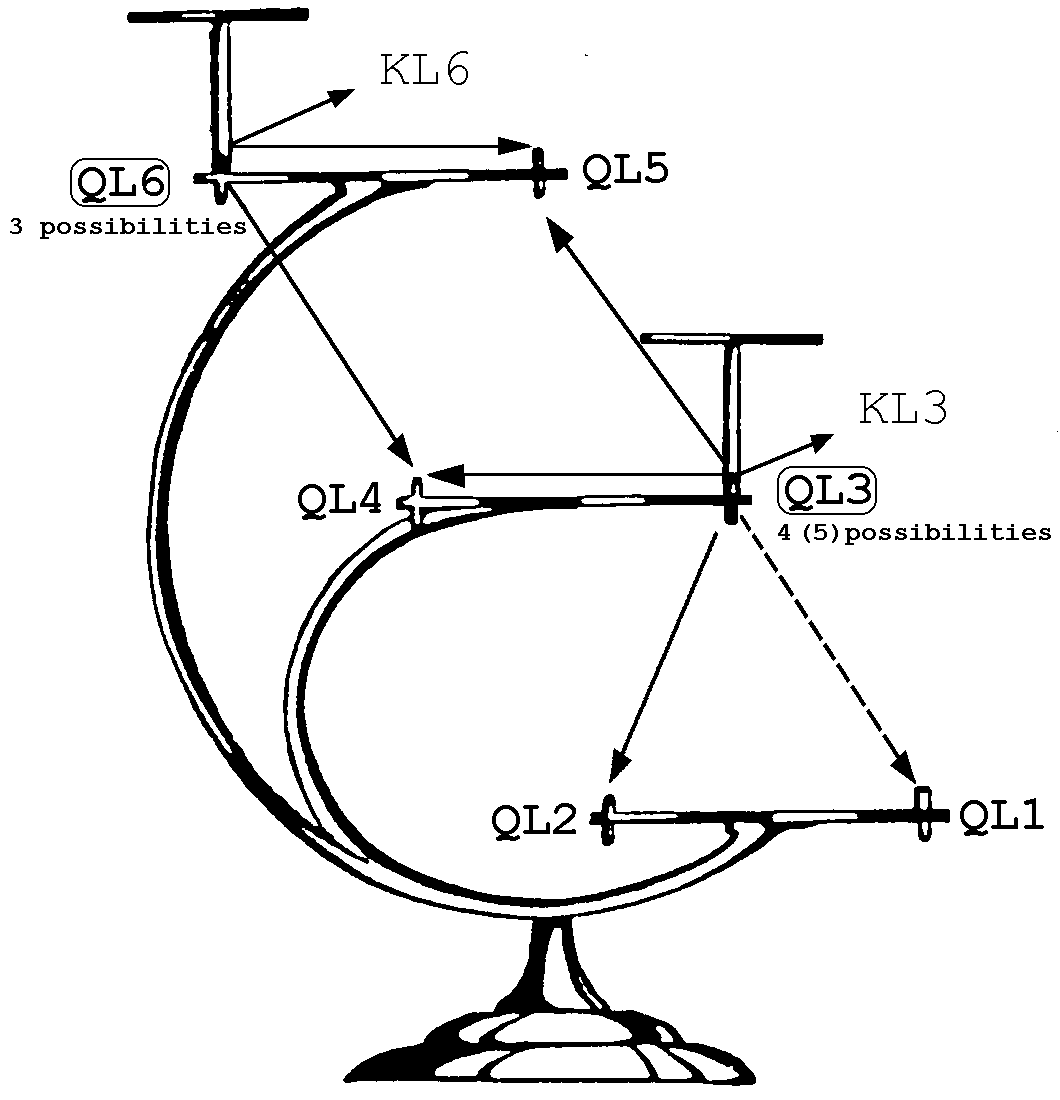
Article 4: The act of moving the pieces
4.1 Players should feel free to use more than one hand when executing moves (such as when moving attack boards) due to the special nature of the 3D-Chess-Set.
4.2 Provided that he first expresses his intention (e.g. by saying "j'adoube"), the player having the move may adjust one or more pieces on their squares.
|
4.3
|
Except as provided in Article 4.2, if the player having the move deliberately touches on the chessboard
|
| |
(a) one or more pieces of the same colour, he must move or capture the first piece touched that can be moved or captured, or
(b) one piece of each colour, he must capture the opponent's piece with his piece or, if this is illegal, move or capture the first piece touched which can be moved or captured. If it is unclear the player's own piece shall be considered to have been touched before his opponent's.
|
|
4.4
|
(a) If a player deliberately touches his king and a rook he must castle on that side if it is legal.
(b) If a player deliberately touches a rook and then his king he is not allowed to castle on that side on that move and the situation shall be governed by Article 4.3.
(c) If a player, intending to castle touches the king or king and a rook at the same time, but castling on that side is illegal, the player must choose either to castle on the other side, provided that castling on that side is legal, or to move his king. If the king has no legal move, the player is free to make any legal move.
|
4.5 If none of the pieces touched can be moved or captured, the player may make any legal move.
4.6 If the opponent violates Article 4.3 or 4.4 the player cannot claim this after he himself deliberately touches a piece.
4.7 When, as a legal move or part of a legal move, a piece has been released on a square, it cannot then be moved to another square. The move is considered to be made when all the relevant requirements of Article 3 have been fulfilled.
Article 5: The completed game
|
5.1
|
(a) The game is won by the player who has checkmated his opponent's king with a legal move. This immediately ends the game.
(b) The game is won by the player whose opponent declares he resigns. This immediately ends the game.
|
5.2 The game is drawn when the player to move has no legal move and his king is not in check. The game is said to end in 'stalemate'. This immediately ends the game.
5.3 The game is drawn upon agreement between the two players during the game. This immediately ends the game. (See Article 9.1)
5.4 The game may be drawn if the identical position is about to appear or has appeared on the chessboard three times. (See Article 9.2)
5.5 The game may be drawn if the last 50 consecutive moves have been made by each player without the movement of any pawn and without the capture of any piece. (See Article 9.3)
|
|
1. What should I know if I can’t understand the diagrams/rules?
It is just normal chess with same rules for movement of your pieces/armies. However, there is another dimension in which the pieces move. So, it is just two added rules and you can observe others and learn quickly.
2. Is it going to be a tournament style or an exhibition match style?
It is more of an exhibition for the first two days rather than a tournament. You could play against your friends or random strangers. There will be a tournament on Day 3. Details will be said in the “Informals space”. You can register for it on Day 1.
3. What do I need in order to play?
You will need to have a Pragyan ID.
4. Where can I register or find the organisers?
Informal desk, Day 1 onwards.
5. Any other queries?
Refer Contacts.
Aniruddhan TA

Harsha Manne

Faculty Advisor
Dr. T. Ramesh
Assistant Professor
Department - Mechanical Engineering
You must be logged in to fill this form.
Click here to login.










